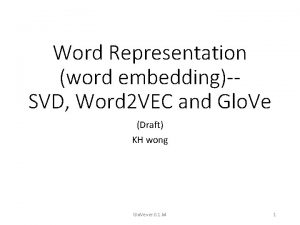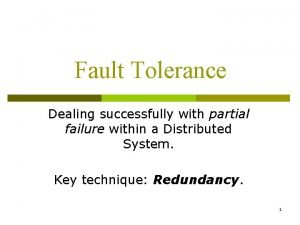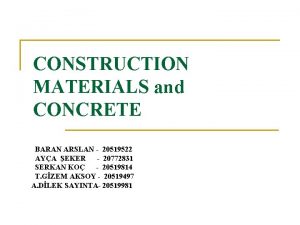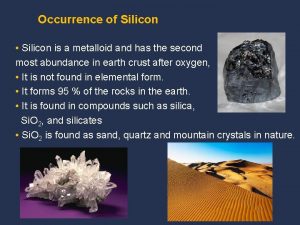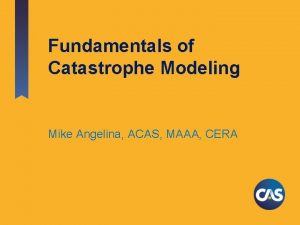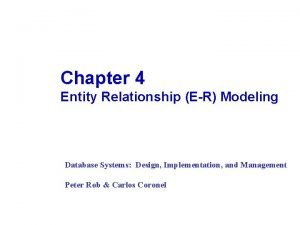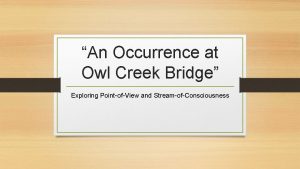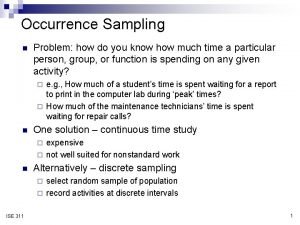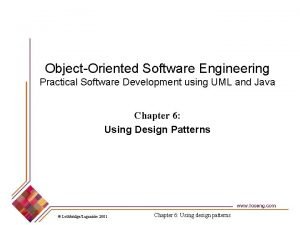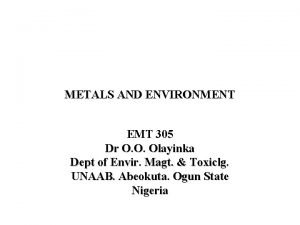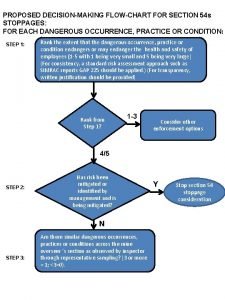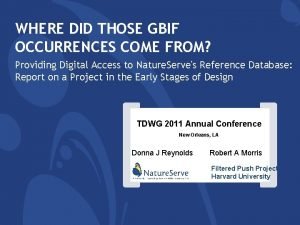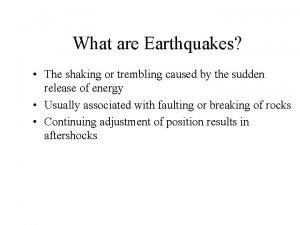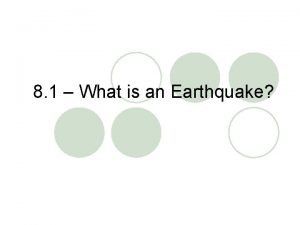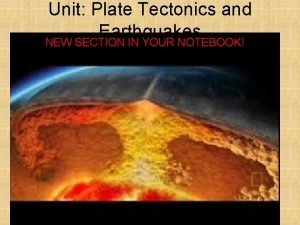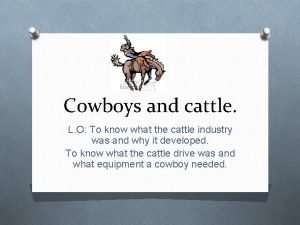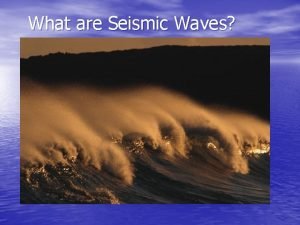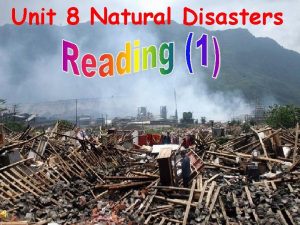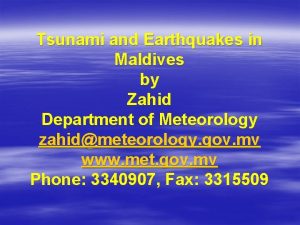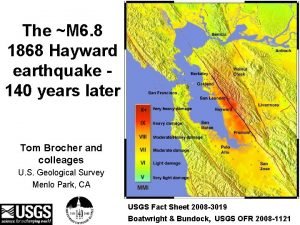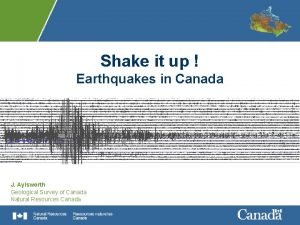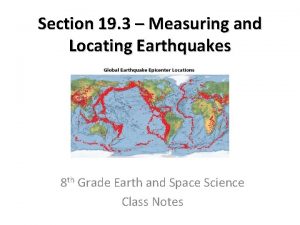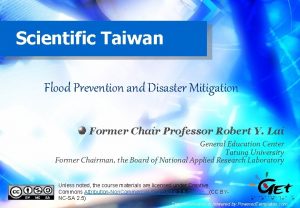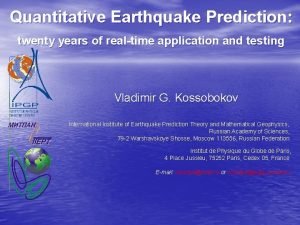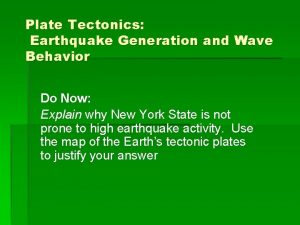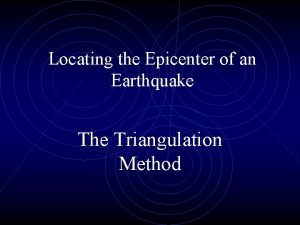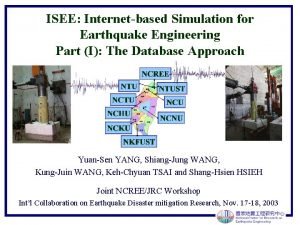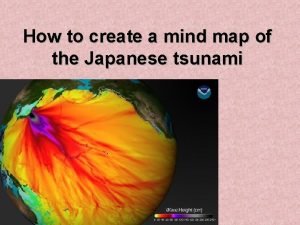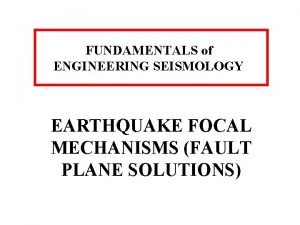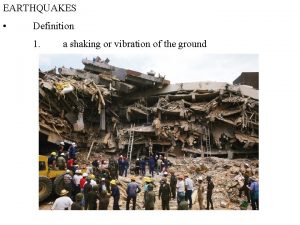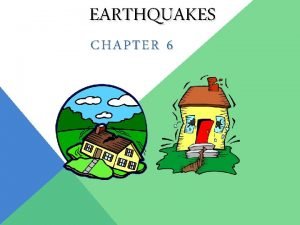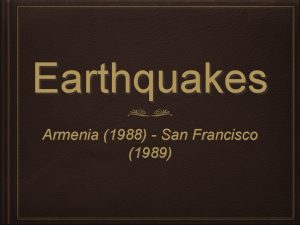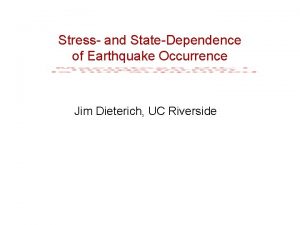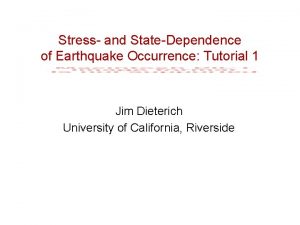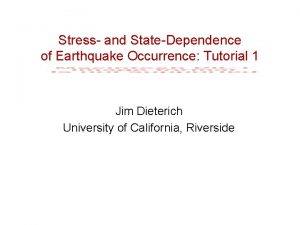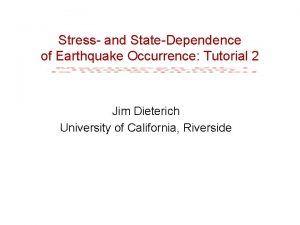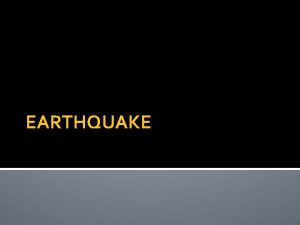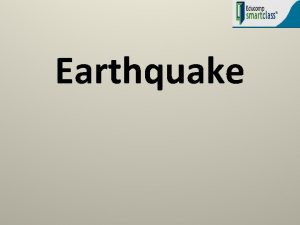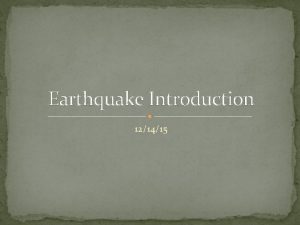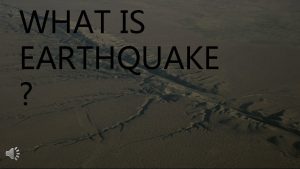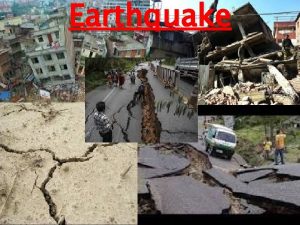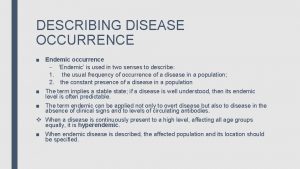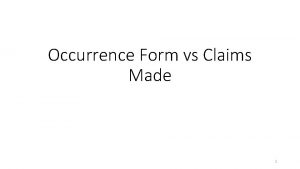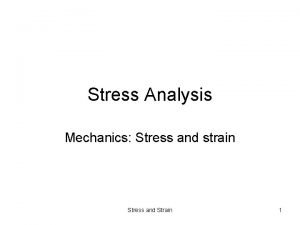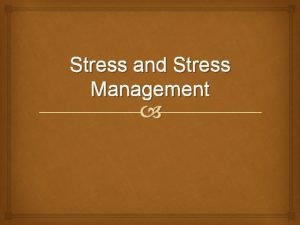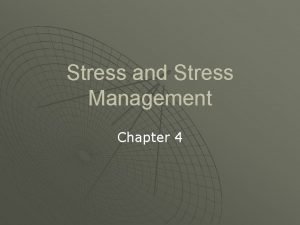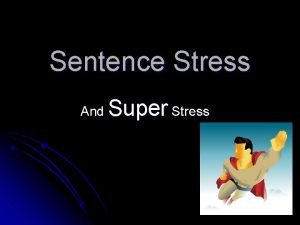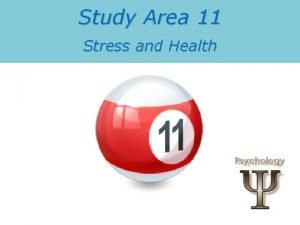Stress and StateDependence of Earthquake Occurrence Jim Dieterich

















































- Slides: 49

Stress- and State-Dependence of Earthquake Occurrence Jim Dieterich, UC Riverside

Formulation for earthquake rates • Unified and quantitative framework for analysis of effects of stress changes on earthquake occurrence • Some applications: – Aftershocks – Foreshocks – Complexity of earthquake events – Triggering of earthquakes by seismic waves – Tidal triggering (why the effect is so weak) – Earthquake probabilities following stress change – Solutions for stress changes from observations of earthquake rates – Stress relaxation by seismic processes for geometrically complex faults

Earthquake rate formulation: Model • Earthquake occurrence is controlled by earthquake nucleation processes • Earthquake nucleation as given by rate- and state-dependent friction is time dependent and highly non-linear in stress and gives the following • Coulomb stress function as • At steady state where The characteristic time to reach steady-state Dieterich, JGR (1994), Dieterich, Cayol, Okubo, Nature, (2000), Dieterich and others, USGS Professional Paper 1676 (2003)

Earthquake rate (R/r ) Earthquake rates following a stress step Time (t / ta )

Stress Aftershock model Earthquake rate Background rate Time Pict of Coulomb change Coulomb stress change Time

Stress Shadow Earthquake rate Background rate Time Coulomb stress change Time

Method: Stress time series STEPS 1) Select region and magnitude threshold 2) Smooth earthquake rate: R(t) 3) Obtain time series for g: 4) Solve evolution equation for Coulomb stress S. For example:

Synthetic Data

Synthetic Data

Figure: Barry Eakins Rift zones modified from Fiske and Jackson (1972) Bathimetry: USGS JAMSTEC

Cross section through east rift of Kilauea

Inversion of EQ rates for stress (1996 -1994) Dieterich and others, 2000, Nature

Method to obtain stress changes from earthquake rates STEPS 1) From earthquake rates obtain time series for g at regular grid points: 2) Solve evolution equation for Coulomb stress S as a function of time at each grid point 3) Prepare maps (or cross sections) of stress changes over specified time intervals Dieterich, Cayol, and Okubo, Nature (2000) Dieterich and others, USGS Prof Paper(2003)

Deformation Seismicity Rift intrusion rate NS extension (Summit region) 1976 -1983 0. 5 MPa/yr 0. 3– 0. 6 MPa/yr 0. 18 km 3/yr 25 cm/yr >1983 (0. 1 MPa) ≤ 0. 1 Mpa/yr 0. 06 km 3/yr 4 cm/yr

Stress changes before 1983 eruption 0. 5 MPa/year Deformation model, 1976 -1983 2 0. 2 MPa/year Seismicity solution, 1980 -1983 Dieterich, Cayol, and Okubo, Nature (2000) Dieterich and others, USGS Prof Paper(2003)

Stress changes at the time of the 1983 intrusion & eruption Deformation model Seismicity solution Dieterich and others, USGS Prof Paper(2003)

Stress changes at the time of the 1977 intrusion & eruption Deformation model


Kalapana Earthquake M 7. 3 1975

Earthquakes M≥ 4. 6 1976 -1979

Earthquakes M≥ 4. 6 1980 -1989

Earthquakes M≥ 4. 6 1990 -1999

M~ 5 Earthquakes following Sept. 13, 1977 eruption M 4. 6 9/27/79 5. 4 9/21/79

M~ 5 Earthquakes following Jan. 1, 1983 eruption M 5. 0 3/20/83 M 5. 2 9/9/83

1/3/83



Geometrically complex faults USGS, 2003

Fault geometry Individual faults exhibit approximately self-similar roughness (fractal dimension~1). Fault in the Monterrey Formation Fault systems also appear to be scale-independent San Francisco Bay Region

Random Fractal Fault Model Solve for slip using boundary elements. Simple Coulomb friction with = 0. 6 Periodic B. C, or slip on a patch = 0. 3 = 0. 1 = 0. 03 = 0. 01

Slip of a fault patch

Fault slip and stress changes Smooth fault Fractal fault: H=1, =0. 01

Fault slip and stress changes Smooth fault Global slip Fractal fault: H=1, =0. 01 Global slip

Non-linear scaling of slip with fault length Region of ~ linear scaling of Slip with fault length Hurst exponent: H = 1. 0 Roughness amplitude: = 0. 05

Non-linear scaling of slip with fault length: Average of slip for n 100 simulations d. MAX = 85 FAULT LENGTH Hurst exponent: H = 1. 0 Roughness amplitude: = 0. 1 Region of ~ linear scaling of slip with fault length

= 0. 01 = 0. 03 = 0. 1 = 0. 3

Non-linear scaling and system size-dependence Geometric complexity forms barriers to slip. Barrier stress increases with total slip and sequesters strain energy that would otherwise be released in slip. The barrier stress acts as an elastic back-stress, which opposes slip. Back-stress increases linearly with slip. when the back-stress equals the applied stress. Back stress, SBACK Slip saturates at SA = Applied stress Slip, d

= 0. 01 = 0. 03 = 0. 1 = 0. 3

Non-linear scaling of slip with fault length Average slip on non-planar faults n~100 Planar fault model with elastic back stress d. MAX = 85 FAULT LENGTH Hurst exponent: H = 1. 0 Roughness amplitude: = 0. 1

Yielding and Stress Relaxation • Stresses due to heterogeneous slip cannot increase without limit some form of steady-state yielding and stress relaxation must occur Slope of 0. 01 shear strain . 01, ����� brittle failure • In brittle crust, stress relaxation may occur by faulting and seismicity off of the major faults. Ø Instantaneous failure and slip during earthquake Ø Post-seismic – aftershocks and long-term seismicity • Yielding will couple to the failure process, by relaxing the backstresses

Landers and Hector Mine Earthquakes Data from Sowers and others (1992) , US Geological Survey

Steady-state yielding by earthquakes: EQ rate µ Coulomb stress rate µ Long-term slip rate

Average long-term earthquake rate by distance from fault with random fractal roughness Earthquake rate • Stressing due to fault slip at constant long-term rate • Model assumes steady-state seismicity at the long-term stressing rate, in regions where

Average long-term earthquake rate by distance from fault with random fractal roughness Earthquake rate Scaling:

Initial Aftershock Rate / Background Rate


Aftershock rates as function of distance 0. 01 – 0. 03 L 0. 03 – 0. 05 L 0. 05 – 0. 07 L 0. 07 – 0. 09 L 0. 09 – 0. 10 L L=rupture length

Conclusions: Seismicity stress solutions • Stress shadows are seen for all earthquakes M≥ 4. 7 • Quantitative agreement of deformation measurements and seismicity stress solutions – Stress changes 1976 -1983 – Stress changes related to 1983 eruption – Stressing rate change 1980 -1983 • Provides greater detail of stress changes at depth than can be obtained from deformation modeling – Resolve stress patterns for earthquakes M~5 at depths of 10 km. This includes stress shadows – Useful for guiding deformation modeling, by eliminating alternative models • Reveals stress interactions between magmatic and earthquake processes at Kilauea volcano

Conclusions - Seismicity and non-planar faults • Fault complexity heterogeneous slip and stress • Fault complexity + elasticity non-linear scaling and system sizedependence • Heterogeneous stresses increase with slip yielding & stress relaxation Slope = 0. 01 shear strain . 01 ����� brittle failure Ø Instantaneous failure and slip during earthquake Ø Fall-off of background seismicity by distance Ø Post-seismic – aftershocks within “stress shadow” • Stress relaxation process will couple to slip on major faults by relaxing the back stresses. Speculation: Ø Restore linear scaling Ø Restore independence of system size
 Engineering vs true stress strain curve
Engineering vs true stress strain curve Chapter 10 stress responses and stress management
Chapter 10 stress responses and stress management What is the definition of axial stress
What is the definition of axial stress Co occurrence matrix example
Co occurrence matrix example Animal texture
Animal texture Hide the occurrence of failure from other processes using
Hide the occurrence of failure from other processes using Gypsum occurrence
Gypsum occurrence Occurrence verbs
Occurrence verbs Occurrence of silicon
Occurrence of silicon Oep and aep catastrophe
Oep and aep catastrophe Strong relationship database
Strong relationship database Irony in an occurrence at owl creek bridge
Irony in an occurrence at owl creek bridge An occurrence at owl creek bridge stream of consciousness
An occurrence at owl creek bridge stream of consciousness Foreshadowing in owl creek bridge
Foreshadowing in owl creek bridge What is the climax of an occurrence at owl creek bridge
What is the climax of an occurrence at owl creek bridge It is an occurrence of harmony
It is an occurrence of harmony Occurrence sampling
Occurrence sampling Abstraction-occurrence design pattern
Abstraction-occurrence design pattern Occurrence of zinc
Occurrence of zinc Dangerous occurrence
Dangerous occurrence Come to occurrence
Come to occurrence An occurrence at owl creek bridge comprehension questions
An occurrence at owl creek bridge comprehension questions Focus and epicenter of an earthquake
Focus and epicenter of an earthquake Focus
Focus Earthquake p-wave and s-wave travel time graph
Earthquake p-wave and s-wave travel time graph Focus and epicenter of an earthquake
Focus and epicenter of an earthquake 1958 lituya bay earthquake and megatsunami
1958 lituya bay earthquake and megatsunami Direct characterization in the gift of the magi
Direct characterization in the gift of the magi Isagenix rank structure
Isagenix rank structure How does huck feel about not turning jim in
How does huck feel about not turning jim in Cattlelo
Cattlelo Type of earthquake waves
Type of earthquake waves Unit 8 natural disasters
Unit 8 natural disasters Maldives earthquake
Maldives earthquake 1868 hayward earthquake
1868 hayward earthquake Grand banks earthquake of 1929
Grand banks earthquake of 1929 Earthquake intensity depends primarily on the height of
Earthquake intensity depends primarily on the height of Taiwan flood
Taiwan flood Taiwan earthquake
Taiwan earthquake Shallow focus earthquake
Shallow focus earthquake Steps in triangulation method in earthquake
Steps in triangulation method in earthquake Taiwan earthquake
Taiwan earthquake Sabiha gökçen international airport earthquake proof
Sabiha gökçen international airport earthquake proof Tsunami mind map
Tsunami mind map Grief is like an earthquake
Grief is like an earthquake Beach ball seismology
Beach ball seismology Two types of body waves
Two types of body waves Epicenter of earthquake
Epicenter of earthquake Liquefaction occurs when seismic waves cause __________.
Liquefaction occurs when seismic waves cause __________. 1988 earthquake san francisco
1988 earthquake san francisco



